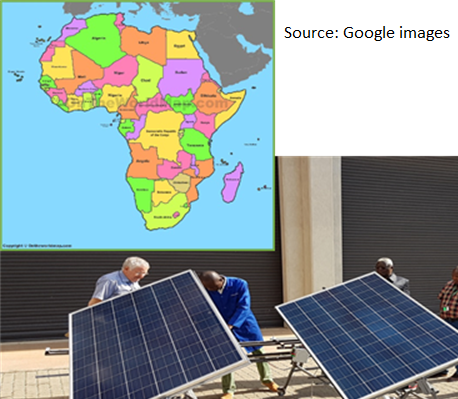Developing a small photovoltaic power supply system with adaptive technologies for rural Africa: Design, cost and efficiency analyses
DOI:
https://doi.org/10.17159/2413-3051/2018/v29i4a5399Keywords:
Renewable energies, Photovoltaic cells, business modelsAbstract
The objective of this study was to design a small-scale photovoltaic system to support electricity supply to a rural village in the Republic of Congo. A simple impedance-matching system and an innovative panel-tilting system were implemented as adaptive technologies to increase the power output of the system and reduce its capital and running costs. The experimentally obtained results showed that the daily energy output of a four-panel, 400 W photovoltaic system could be increased by 15% through a series parallel impedance match configuration, and by 36% from 3.3 kWh per day to approximately 4.5 kWh per day through implementing an automated panel tilting system with always normal incidence of solar irradiation on the panels in an equatorial environment. Implementing these technologies accordingly reduced the cost of energy supplied by the same percentages, with an eventual electricity cost of about ZAR 3.60 per kWhr, as calculated over an operation time of ten years, and an initial capital outlay of ZAR 37 per watt. These costs are much lower than for installing power grid lines to the village, and the technology also ensures complete autonomy of power supply to the community. The study also identified the potential to generate many new business and job opportunities locally in this community, as well as in the rest of Africa.
Downloads
References
Boitier, V. and Alonso, C. 2005. Dimensionnement d'un système photovoltaïque, CETSIS'2005, Nancy, 25-27 Available at: vin-cent.boitier.free.fr/LPCCSEE/BE/PV/Boitier_Alonso.pdf ; accessed July 2017.
Eshita, S. T. and Hossain, A. 2010. Design and simulation of a solar PV system. Thesis Department of Electrical and Electronics, BRAC University, Dha-ka, Bangladesh : 1–46. Available at: dspace.bracu.ac.bd:8080/xmlui/.../thesis%20-%201%20report.pdf?...1, accessed July 2018.
Chandra Mouli, G. R., Bauer, P. and Zeman, M. 2016. System design for a solar-powered electric vehicle charging station for workplaces, Applied Energy 168:434-443.
https://doi.org/10.1016/j.apenergy.2016.01.110
Hadj Arab, A, Gharbi, A and Benghanem, M., 2005. Dimensionnement des systèmes de pompage pho-tovoltaïque. Revue des Energies Renouvelables, 8:19–26.
Homer Energy. 2017. Optimization engine for compiling and modelling solar energy supply systems . As available at https://www.homerenergy.com/products/grid/features.html, accessed July 2017.
International Energy Agency. 2014. Solar Photovoltaic Energy, Technology Roadmap, Renewable Energy Division. Available at: https://www.iea.org/publications/freepublications/.../pv_roadmap.pdf, accessed July 2017
IGrid Solar Pty Ltd. 2017. Solar thermal systems mod-ules trainers text book, study materials in renewable energy for ITI students. Content Development, Edit-ing, Design and Layout New Concept Information Systems Pty. Ltd. Available at: https://mnre.gov.in/.../UserFiles/.../Trainers%20Textbook%20-%20Solar, accessed July 2017.
Jiang, J, Huang, T, Hsiao, Y & Chen, C., 2005. Maxi-mum power tracking for photovoltaic power systems. Tamkang Journal of Science and Engineering 8(2):147–153.
Marneni, A, Kulkarni, AD & Ananthapadmanabha, I., 2015. Loss reduction and voltage profile improve-ment in a rural distribution feeder using solar photo-voltaic generation and rural distribution feeder opti-mization using HOMER. Procedia Technology, 21:507–513. https://doi.org/10.1016/j.protcy.2015.10.036
Moolman, S. 2017. 350% increase in a decade:How expensive is electricity in South Africa compared to other countries? http://www.poweroptimal.com/350-increase-decade-expensive-electricity-south-africa-compared-countries/, accessed July 2017.
Nazar, R., 2015. Improvement of efficiency of solar pan-el using different methods. International Journal of Electrical and Electronics Engineers, 7(1):12–17.
Synergy Energy Solutions.2017. PV Hybrid Systems and Solar Energy Solutions. 2017; available at www.synergyenergy.co.za, accessed July 2017.
International Finance Corporation . 2017. Pro-ject developer's guide to utility-scale so-lar photovoltaic power. O&M Workers at a Large-scale Solar PV. Available at: www.ifc.org/wps/wcm/connect/.../IFC+Solar+Report_; accessed July 2017.
Prasetyaningsari, I, Setiawan, A & Setiawan, AA., 2013. Design optimization of solar powered aeration sys-tem for fish pond in Sleman Regency, Yogyakarta using HOMER software. Energy Procedia, 32:90–98. https://doi.org/10.1016/j.egypro.2013.05.012
Satyen, K. 2000. Recent developments in high-efficiency PV Cells, World Renewable Energy Congress VI, NREL/CP-590-28060. Available at: www.nrel.gov/docs/fy00osti/28060.pdf
Sachin, S. 2012. Numerical Integration (quadrature) pdf.department of scientific computer Available at: https://people.sc.fsu.edu/~sshanbhag/NumericalIntegration.pdf.
Sustainable Energy Authority of Ireland (SEAI). 2017 Best practice guide photovoltaics: 1–70. Available at: https://www.seai.ie/resources/.../Best_Practice_Guide_for_PV.pdf, accessed July 2017.
Setiawan, A & Setiawan, AA., 2013. Community devel-opment in solar energy utilization to support fish farming in Sendangsari village. Energy Procedia, 32:39–46. https://doi.org/10.1016/j.egypro.2013.05.006
Sze, S.M., 1981. Physics of semiconductor devices, 2nd edition, New York, NY, USA: Wiley.

Downloads
Published
Issue
Section
License
Copyright (c) 2018 Steve Mvili-Gampo, Lukas W. Snyman

This work is licensed under a Creative Commons Attribution-ShareAlike 4.0 International License.



.png)